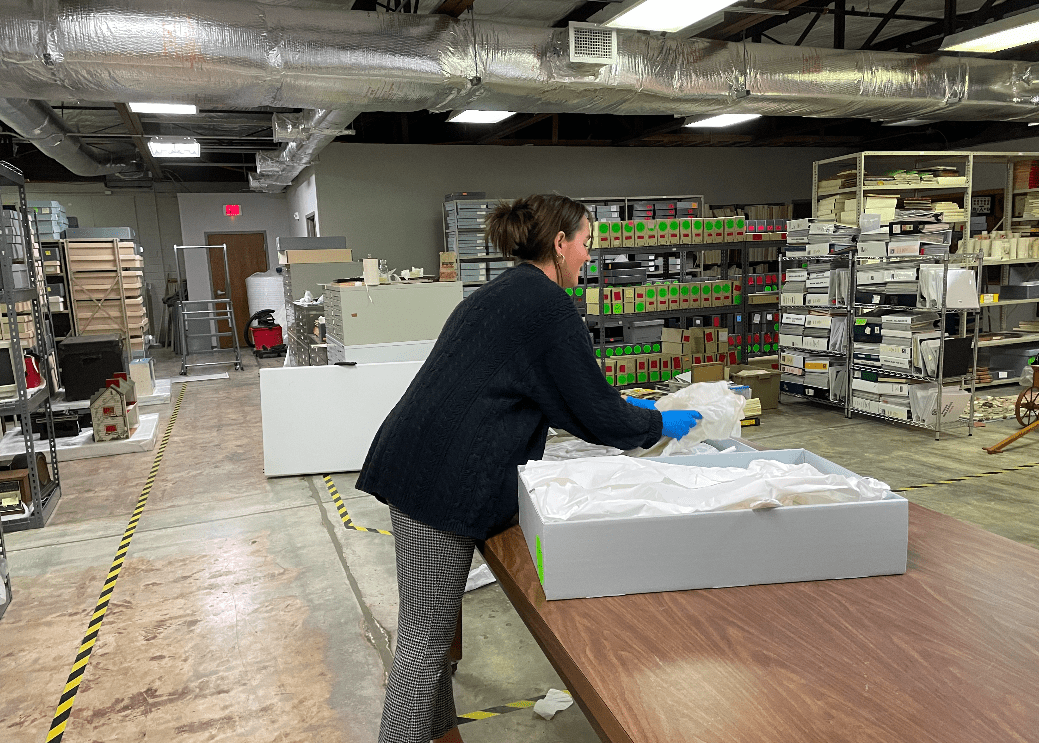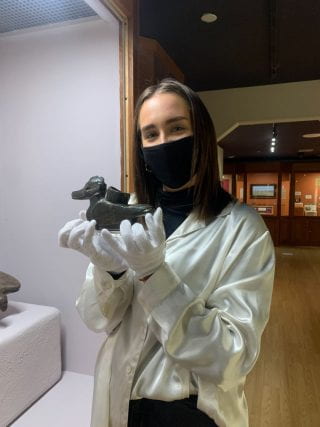
Olivia catalogs each item within the collections facility at the Rogers Historical Museum. In order to keep up with records, she is finding the catalog number on each item to ensure it’s in the correct case and not damaged.
Olivia Ervin is an honors sophomore from Bentonville, Arkansas, who is double majoring in biological anthropology and English with a minor in gender studies. Last year, Olivia got involved with the Associated Student Government and currently serves as the Director of Sustainability. In summer 2021 Olivia shadowed staff in a plethora of museums within the Northwest Arkansas area through an internship set up by the Honors College.

Olivia organizes the display case at the Museum of Native American History in Bentonville. She is holding a stone effigy duck vessel, wearing specific gloves to ensure no fingerprints are left on the vessel.
This past summer I had the privilege of being able to shadow six of Northwest Arkansas’ finest museums. The goal of this internship was to gain a comprehensive understanding of how the museum industry works. Whether it is small or large, private or public, art or history – every museum is certain to fall victim to the perils of funding, staffing, etc. Whether it is a multimillion-dollar museum or a local hometown museum, both face unique challenges and tribulations. Like many other UA students, I would absolutely love to work in some sort of museum in the future. So – to simplify my findings I have created an organized list of the top eight things you might want to know before working in a museum.
- Large versus Small
The Peel Mansion would be considered a small museum due to its smaller staff size as well as overall physical size. Against the same metric, the Shiloh and Rogers museums would be considered mid-size and Crystal Bridges would be large. To the guests’ view, the only difference between these is the general lot size; however, to the workers this can be a matter of how many responsibilities one takes with a single title.
- Private Versus Public
Now most of us have heard of public versus private in some sense (potentially from one of my earlier blog posts!) However, when we hear of this, we often think of health care, education or something like that. In the museum world, it all boils down to who is financially supporting the museum. If it is the government (municipal, state or national) it is a public museum. However, if it a person, foundation, etc., it is a public museum. This distinction is important in how the museum functions and the rules it must follow. For example, during the pandemic, the municipally-funded museum had to follow local and state guidelines over mask usage. However, privately-funded museums had the liberty to set their own guidelines as an independent business. - The Decision Making
In my opinion, the most arduous task of entering the museum world is deciding what position one would be best suited for. Contrary to widespread belief, museum staff is comprised of more than just a curator. One can be an educator, a director, an engagement and interpretation specialist, a director of development, an exhibition specialist, collections manager, etc. - RESEARCH, RESEARCH, RESEARCH
Not to simply preach the obvious but working in any area of a museum means doing LOTS of research. Monte Harris, programs educator at the Rogers Historical Museum, described that a substantial part of what she does in her day-to-day job is conducting research. Whether it be preparing for adult education seminar, or for an upcoming exhibit, it is all about the research. - Museums are a cold, cold world
This might be a tad on the silly side, but if you have low iron like me, it’s crucial. Museums are almost always cold. The reason for this relies heavily on the preservation of the artifacts. Regardless of what type of museum you work in, preservation is key to keeping the show on the road. So, it might be important to layer up anytime you go into a museum. - Cooperation is key
In the museum industry, no job is an island. Rather, each position works closely together with every other department to present exhibitions. Curators must work closely with exhibit coordinators, interpretation specialists, etc. in order to create the exhibit. Education directors also work closely with all the previously stated departments in order to create lecture ideas and lesson plans. No idea or exhibit can be truly credited to one person. In the smaller museums such as Shiloh, they do not have a curator at all. Rather, the entire staff comes up with the ideas for an exhibit and work closely together on building it. However, at a larger museum like Crystal Bridges, an entire department is dedicated to curatorial. So, they work inter-departmentally to create the exhibits. - American Alliance of Museums (The Big Dogs)
The American Alliance of Museums is an organization that connects museums across the nation. Becoming a member of this organization grants museums different opportunities such as resources, grants, etc. In addition to these opportunities, museums can apply for accreditation. Accreditation in the museum industry is a seal of approval from the AAM saying the museum is up to their standards. However, this process is tedious and time consuming. Smaller museums often do not have the staff and resources necessary to devote to the strenuous process. Out of the six museums I visited, the only accredited museum in our area is the Rogers Historical Museum. This raises another point – to be accredited is not necessarily to be “better” than the other museums. Rather it is just showing that the museum has gone through the process successfully. After 10 years, the accreditation must be renewed again. - Barriers of Entry
At every museum I visited, their parting words were nearly identical –– “Make sure to have internships in college.” Nearly everyone I talked to about their work history had to work at least a couple of years after graduate school in unpaid internships and volunteer positions. Oftentimes they would have to pick up jobs outside of the museum industry, working as a secretary or even a grocery store clerk. Aaron Loehndorf, the collections and education specialist at the Shiloh Museum, asked during his interview, “is this a permanent position?” I don’t say this to scare, but rather to prepare. Entering the museum industry is rarely something done by accident.
